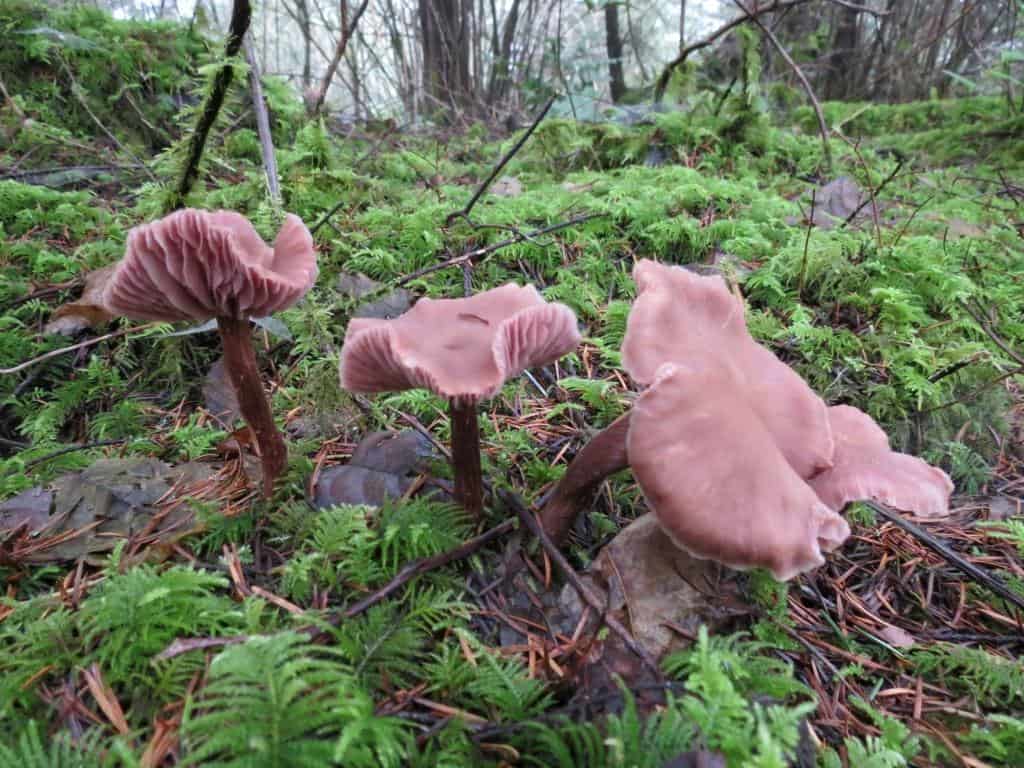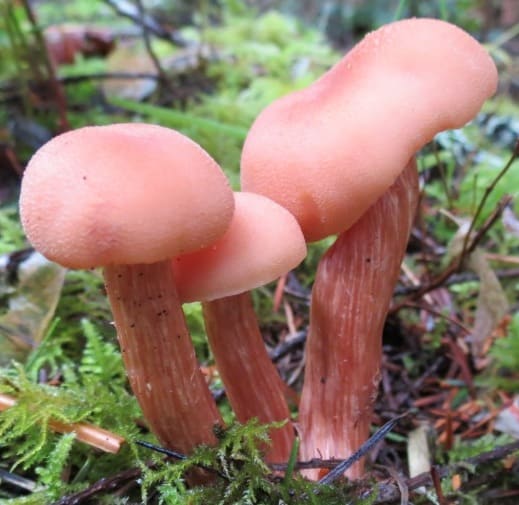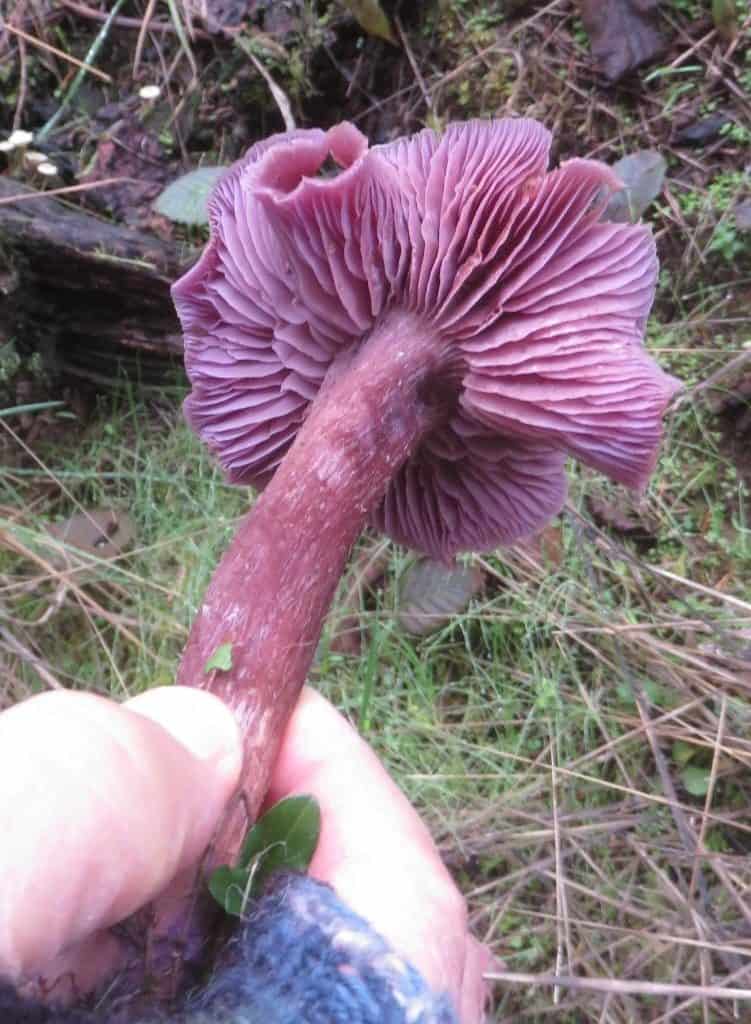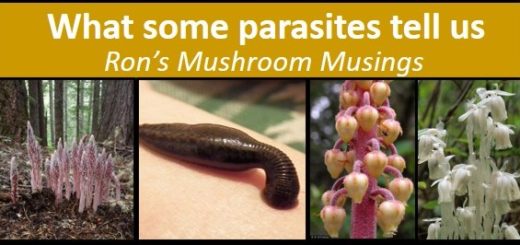The tough but tasty Laccaria

Mushroom species in the genus Laccaria come in several colors in our region of Oregon but fortunately all are fairly easy to identify. The first time Sandy and I became acquainted with Laccaria species was on a mushroom hunting trip with Harriet Kelly. Harriet was quite fond of these mushrooms and referred to them as “The Bacon Mushroom”. We didn’t fully understand the bacon inference until she started frying up their stems later that day. The cooking process took quite a bit of time to complete as the stems transformed themselves from their natural brownish orange/peachy buff color, to slightly golden, to pitch black and reduced to a fraction of their original stem size. Presto change-o, mushroom bacon sticks had been magically created right before our eyes. After a few minutes of resting the bacon sticks on some paper towels to sop up some of the excess oil, it was time for the taste test. I picked up one of the nuclear charred stems and started chewing. Unfortunately, when you ask long time vegetarians to see if they get that bacon flavor, it requires thinking way back in time to your last BLT sandwich along with using some very creative taste-bud imagination. Was it bacon? Well it could have been as the texture seemed right and it had that pleasant deep fried taste. Although, as vegetarians one should be suspect of any conclusions Sandy and I reached that day. All in all, it didn’t really matter as we had a great time in the woods, learned about a new mushroom, and had the opportunity to eat some simulated bacon suitable for vegetarians. Aside from the stem and its bacon potential, Laccaria caps are far less dense than their stems and are easily sautéed, much in the same way as most other mushrooms.

So, if you’re interested in creating your own version of Laccaria bacon or simply want to add another edible mushroom to your foraging list, here’s how to find this attractive mushroom. In Oregon, the genus Laccaria is mycorrhizal with conifer trees and is therefore easily found in our very abundant conifer forests. We find them at the Coast, in the Willamette Valley, and in the Cascade mountain range. The Laccaria species Sandy and I mostly encounter is Laccaria laccata. With a peachy to peach buff color when young, it is easily spotted alongside paths, gravel roads, and in the woods.
An excellent identification test, which we ask people to try on our forays, is to hold the top and bottom ends of the stem and try to slowly tug it apart. As demonstrated in the video below, this task is easier said than done. Because the stem is very fibrous and sometimes twisted like rope, it is quite tough and durable. As seen in the picture above, it can also have whitish colored stripes interlaced within the peachy colored stem. The gills of Laccaria species are very bladelike. Some gills are attached to the stem while others are completely unattached or free. Gill color will vary depending on the species of Laccaria you find. Caps can become quite large as they age and generally take on a wavy character. The best thing about Laccaria species is they start fruiting fairly early in the fall and can persist well into the winter.

Another common species of Laccaria in our area has the ridiculously long name of Laccaria amethysteo-occidentalis. The name is more reminiscent of a moniker associated with some spooky, older than dirt Magician dressed in all black or perhaps an outmoded Carnival Ringmaster from long ago. Saying this species name should always be preceded by the phrase; “Now introducing”. In any event, and for the sake of brevity, most refer to this attractive mushroom by its common name of “amethyst laccaria”. The dominate characteristic of this species is its purple coloration, especially when it first develops. In time, the color will fade to a more pinkish buff color similar to Laccaria laccata. While other genera contain purple colored mushrooms, I do not know of any that can stand up to the stem-tugging test like Laccaria species can. One additional species you can find is called Laccaria bicolor, which has a peachy buff cap color and gills with a purplish hue. One might conclude L. bicolor to be an offspring of some seedy affair between L.laccata and L.amethysteo-occidentalis. Fortunately, as we all know, I am not one to engage in spreading rumors. Regardless of which species of Laccaria you find, their stems can be turned into simulated bacon sticks and their caps sautéed for your favorite mushroom meal. They are easy to clean and the sautéed caps have a good flavor and texture somewhat like a very lean steak. Happy mushroom hunting, stay safe, and always be 10,000% certain of your mushroom identification.





